1997 HONDA ODYSSEY wheel size
[x] Cancel search: wheel sizePage 173 of 241
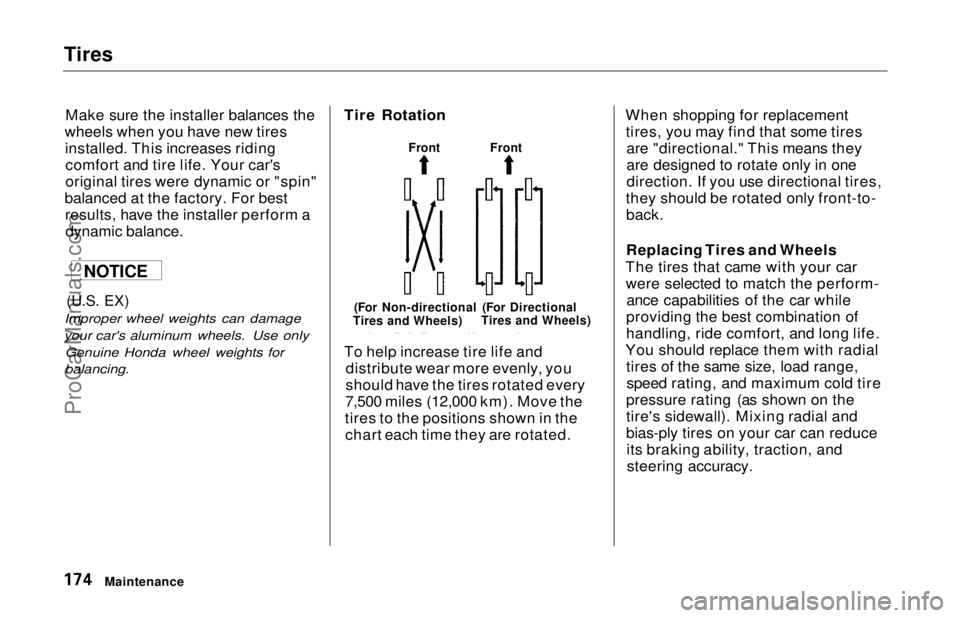
Tires
Make sure the installer balances the
wheels when you have new tires installed. This increases ridingcomfort and tire life. Your car's
original tires were dynamic or "spin"
balanced at the factory. For best results, have the installer perform adynamic balance.
(U.S.
EX)
Improper wheel weights can damage
your car's aluminum wheels. Use only Genuine Honda wheel weights for
balancing.
Tire Rotation
To help increase tire life and
distribute wear more evenly, you
should have the tires rotated every
7,500 miles (12,000 km). Move the
tires to the positions shown in the chart each time they are rotated. When shopping for replacement
tires, you may find that some tires are "directional." This means they
are designed to rotate only in one
direction. If you use directional tires,
they should be rotated only front-to- back.
Replacing Tires and Wheels
The tires that came with your car were selected to match the perform- ance capabilities of the car while
providing the best combination of
handling, ride comfort, and long life.
You should replace them with radial tires of the same size, load range,speed rating, and maximum cold tire
pressure rating (as shown on the
tire's sidewall). Mixing radial and
bias-ply tires on your car can reduce its braking ability, traction, andsteering accuracy.
Maintenance
NOTICE
Front
Front
(For Non-directional
Tires and Wheels)
(For Directional
Tires and Wheels)ProCarManuals.comMain Menu Table of Contents s t
Page 174 of 241
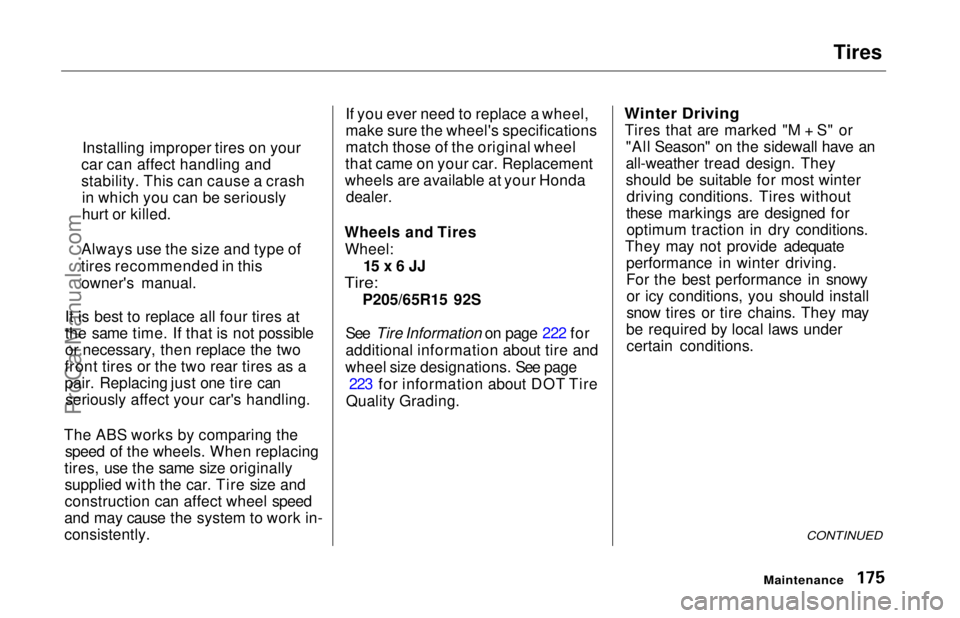
Tires
It is best to replace all four tires at
the same time. If that is not possible
or necessary, then replace the two
front tires or the two rear tires as a
pair. Replacing just one tire can seriously affect your car's handling.
The ABS works by comparing the speed of the wheels. When replacing
tires, use the same size originally supplied with the car. Tire size and
construction can affect wheel speed
and may cause the system to work in-
consistently. If you ever need to replace a wheel,
make sure the wheel's specifications
match those of the original wheel
that came on your car. Replacement
wheels are available at your Honda
dealer.
Wheels and Tires Wheel: 15 x 6 JJ
Tire:
P205/65R15 92S
See Tire Information on page 222 for
additional information about tire and
wheel size designations. See page 223 for information about DOT Tire
Quality Grading.
Winter Driving
Tires that are marked "M + S" or "All Season" on the sidewall have an
all-weather tread design. They
should be suitable for most winterdriving conditions. Tires without
these markings are designed for optimum traction in dry conditions.
They may not provide adequate performance in winter driving.
For the best performance in snowyor icy conditions, you should install
snow tires or tire chains. They may
be required by local laws under certain conditions.
CONTINUED
Maintenance
Installing improper tires on your
car can affect handling and
stability. This can cause a crash in which you can be seriously
hurt or killed.
Always use the size and type of
tires recommended in this owner's manual.ProCarManuals.comMain Menu Table of Contents s t
Page 175 of 241
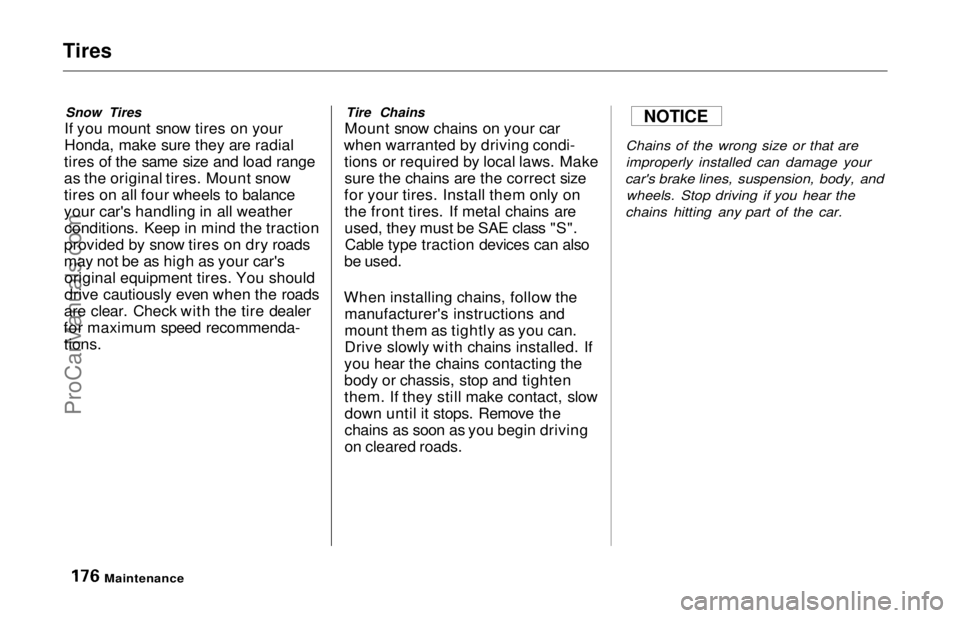
Tires
Snow Tires
If you mount snow tires on your
Honda, make sure they are radial
tires of the same size and load range
as the original tires. Mount snow
tires on all four wheels to balance
your car's handling in all weather conditions. Keep in mind the traction
provided by snow tires on dry roads
may not be as high as your car's original equipment tires. You should
drive cautiously even when the roads
are clear. Check with the tire dealer
for maximum speed recommenda- tions. Tire Chains
Mount snow chains on your car
when warranted by driving condi- tions or required by local laws. Makesure the chains are the correct size
for your tires. Install them only on the front tires. If metal chains are
used, they must be SAE class "S".Cable type traction devices can also
be used.
When installing chains, follow the manufacturer's instructions and
mount them as tightly as you can.
Drive slowly with chains installed. If
you hear the chains contacting the
body or chassis, stop and tighten
them. If they still make contact, slow down until it stops. Remove the
chains as soon as you begin driving
on cleared roads.
Chains of the wrong size or that are
improperly installed can damage your
car's brake lines, suspension, body, and
wheels. Stop driving if you hear the
chains hitting any part of the car.
Maintenance
NOTICEProCarManuals.comMain Menu Table of Contents s t
Page 192 of 241
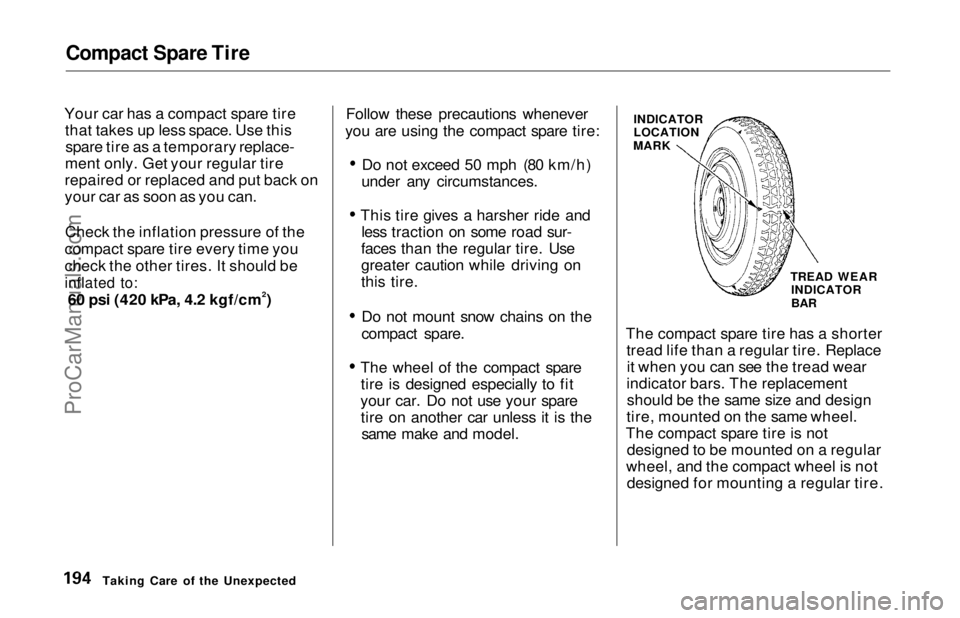
Compact Spare Tire
Your car has a compact spare tire that takes up less space. Use thisspare tire as a temporary replace-
ment only. Get your regular tire
repaired or replaced and put back on
your car as soon as you can.
Check the inflation pressure of the
compact spare tire every time you
check the other tires. It should be
inflated to:
60 psi (420 kPa, 4.2 kgf/cm2) Follow these precautions whenever
you are using the compact spare tire:
Do not exceed 50 mph (80 km/h)
under any circumstances.
This tire gives a harsher ride and less traction on some road sur-
faces than the regular tire. Use
greater caution while driving on
this tire.
Do not mount snow chains on the
compact spare.
The wheel of the compact spare tire is designed especially to fit
your car. Do not use your spare tire on another car unless it is the same make and model. The compact spare tire has a shorter
tread life than a regular tire. Replaceit when you can see the tread wear
indicator bars. The replacement should be the same size and design
tire, mounted on the same wheel.
The compact spare tire is not designed to be mounted on a regular
wheel, and the compact wheel is not designed for mounting a regular tire.
Taking Care of the Unexpected INDICATOR
LOCATION
MARK
TREAD WEARINDICATOR
BARProCarManuals.comMain Menu Table of Contents s t
Page 214 of 241
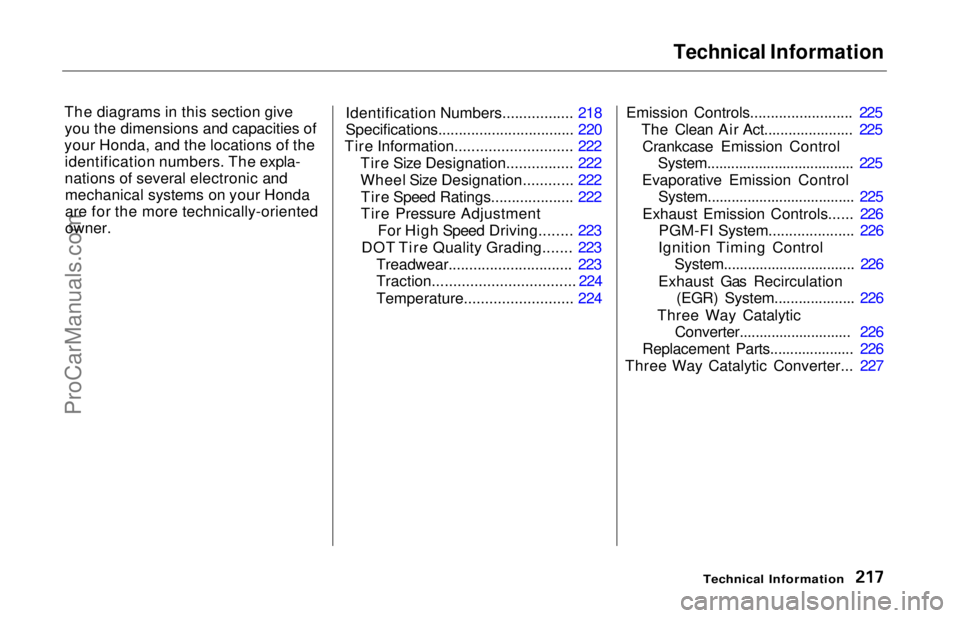
Technical Information
The diagrams in this section give you the dimensions and capacities of
your Honda, and the locations of the identification numbers. The expla-
nations of several electronic andmechanical systems on your Honda
are for the more technically-oriented
owner. Identification Numbers................. 218
Specifications................................. 220
Tire Information............................ 222
Tire Size Designation................ 222
Wheel Size Designation............ 222Tire Speed Ratings.................... 222
Tire Pressure Adjustment For High Speed Driving........ 223
DOT Tire Quality Grading....... 223 Treadwear.............................. 223
Traction.................................. 224
Temperature.......................... 224 Emission Controls......................... 225
The Clean Air Act...................... 225Crankcase Emission Control System..................................... 225
Evaporative Emission Control System..................................... 225
Exhaust Emission Controls...... 226 PGM-FI System..................... 226
Ignition Timing Control System................................. 226
Exhaust Gas Recirculation (EGR) System.................... 226
Three Way Catalytic Converter............................ 226
Replacement Parts..................... 226
Three Way Catalytic Converter... 227
Technical InformationProCarManuals.comMain Menu s t
Page 219 of 241

Tire Information
Tire Size Designation
A tire's sidewall is marked with a tire size designation. You will need this
information when selecting replace-
ment tires for your car. The follow-
ing explains what the letters and
numbers in the tire size designation
mean.
(Example tire size designation)
P205/65R15 92S
P —
Applicable vehicle type (tires
marked with the prefix "P" are
intended for use on passenger cars;
however, not all tires have this
marking).
205 —
Tire width in millimeters.
65 —
Aspect ratio. The tire's section
height as a percentage of its width.
R —
Tire construction code (Radial).
15 —
Rim diameter in inches. 92
—
Load Index, a numerical code
associated with the maximum load
the tire can carry.
S —
Speed Rating Symbol. See the
speed rating chart in this section for
additional information.
Wheel Size Designation
Wheels are also marked with important information that you needif you ever have to replace one. The
following explains what the letters and numbers in the wheel size
designation mean.
(Example wheel size designation)
15
x
6
JJ
15 —
Rim diameter in inches.
6 —
Rim width in inches.
JJ —
Rim contour designation.
Tire Speed Ratings
The chart below shows many of the
different speed ratings currently
being used for passenger car tires.
The speed rating symbol is part of the tire size designation on the
sidewall of the tire. This symbol
corresponds to that tire's designed
maximum safe operating speed.
Technical InformationProCarManuals.comMain Menu Table of Contents s t